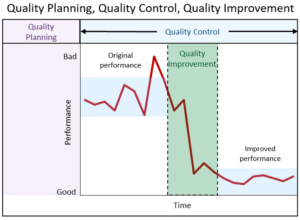QI Methodologies
High functioning systems use a combination of quality planning, quality control and quality improvement. Joseph Juran, one of the early architects of the quality improvement movement, spoke of these 3 approaches as the “quality trilogy.”
- Quality planning – This step proceeds the other two. It involves identifying relevant measures to follow over time, or track, based priorities. A goal or target is set for each measure, based on current performance and what top performing systems have achieved. Comparing to top performers is also known as “benchmarking.”
- Quality control – Relative to planning and improvement, quality control usually is performed over the longest period of time. It involves tracking performance on relevant measures to make sure performance gains are sustained, and takes steps to correct any performance losses that might occur.
- Quality improvement – Quality improvement typically occurs through targeted, time bound projects. Project activities center on reaching specific and measureable goals.
There are multiple methodologies, or approaches, used to meet these ends. Some approaches are more applicable to different quality-related activities than others, and often a mix of methods are used in high performing systems. Commonly used approaches include:
- The goal of Six Sigma is to eliminate defects and waste by streamlining and improving business processes. An example of when to use Six Sigma includes designing a new surgical unit so that its layout is optimized for specific procedures.
- Lean is a set of operating philosophies and methods that help create maximum value for patients by reducing waste and waits. It emphasizes consideration of customer needs, employee involvement and continuous improvement. It is especially useful when organizing workspaces and optimizing supply flow.
- The Model for Improvement is a simple, yet powerful approach for accelerating learning by introducing iterative, small scale experiments into an existing process. It involves asking three questions (What are we trying to improve? How do we know a change is an improvement? What changes can we make that will result in improvement?), followed by a cycle. The cycle is where change ideas are tested is known as the Plan-Do-Study-Act cycle. This approach can be especially valuable when looking to optimize clinic workflows.

